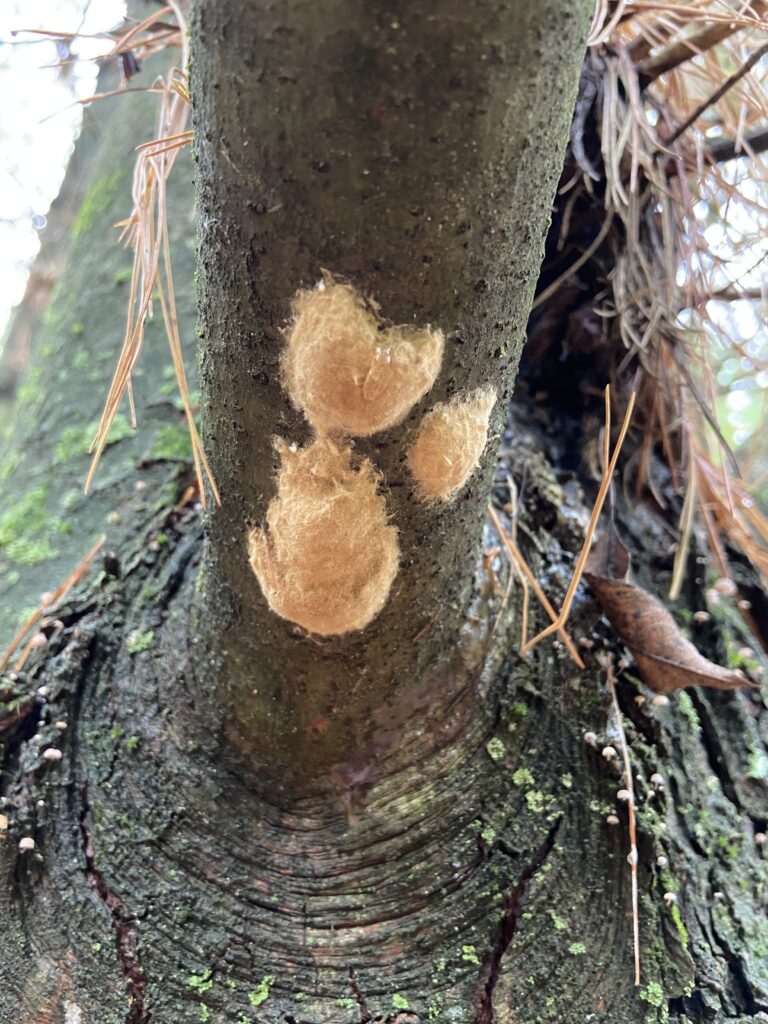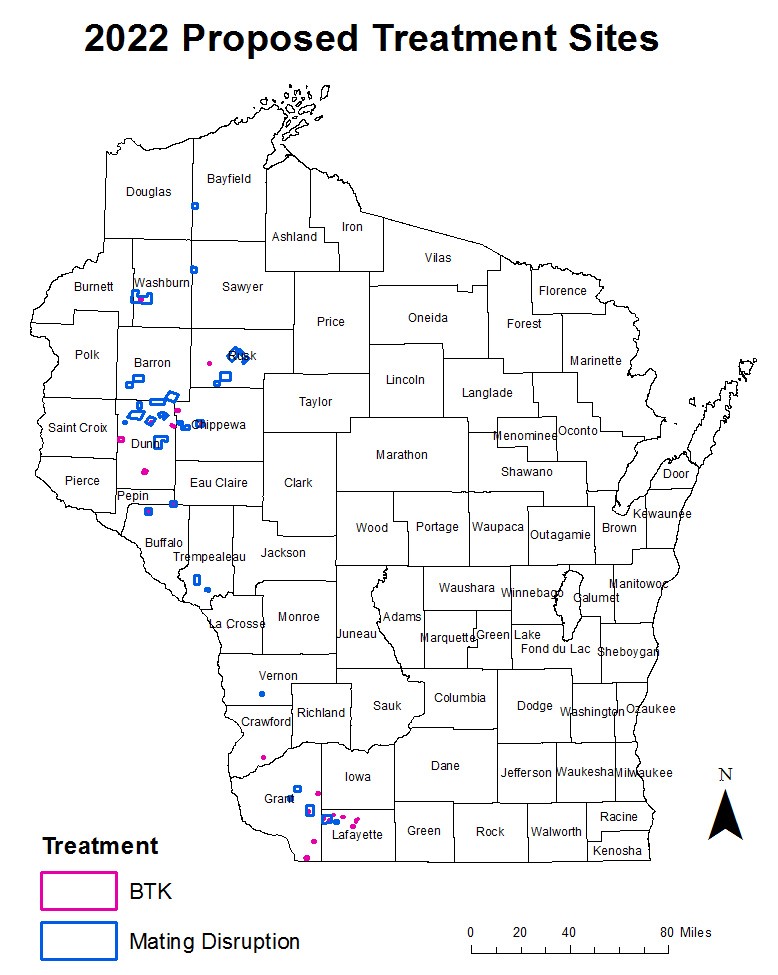By Bill McNee, DNR Forest Health Specialist, Oshkosh
bill.mcnee@wisconsin.gov or 920-360-0942

Three spongy moth egg masses on the underside of a pine branch in Walworth County.
Photo: Bill McNee, Wisconsin DNR
Spongy moth* (formerly known as gypsy moth) egg masses typically begin to hatch in April as temperatures warm. Now is a great time to inspect your trees for egg masses and treat or remove any masses within reach. Each mass that hatches may produce up to 1,000 leaf-eating caterpillars.
Populations of spongy moths increased in 2020 and 2021 due to favorable weather conditions. This winter’s temperatures have not been cold enough to cause heavy egg mortality. A large rise in caterpillar numbers can be expected in 2022 if weather conditions are warm and dry over the next few months.
What To Look For And How To Treat Them
Egg masses are tan-colored lumps around the size of a nickel or a quarter. They can be found on outdoor surfaces, such as tree trunks, the undersides of branches, buildings, rocks, fences, retaining walls, firewood piles and picnic tables. The highest populations and most rapid population increases are usually found where oaks and other preferred species are growing on mowed lawns, street terraces or sandy soil.
If you find an egg mass, there are two options to help reduce pest numbers. The first is to spray horticultural oils directly on the egg masses to suffocate them. These oils are typically applied when temperatures are above 40 degrees and are not expected to dip below freezing for a few days. Adding a little food coloring to the spray mix helps identify the masses you’ve already treated.
Another option is to scrape egg masses into a can of soapy water, leaving them to soak for a few days before throwing them in the trash.
No matter how you choose to get rid of them, target egg masses that were produced the previous summer. Older masses that are faded and feel spongy do not contain viable eggs and do not need to be oiled or removed.
Bacterial or chemical insecticide treatments may be appropriate for larger trees with many egg masses. Some treatments (tree or soil injections, soil drenches or sprays) can be applied before the eggs hatch, and some are done while the caterpillars are small. A directory of for-hire certified arborists is available on the Wisconsin Arborist Association website, and other businesses offering insecticide treatments may be found online or in a phone book.
A survey method for predicting the level of this summer’s defoliation is available on UW Extension’s Pest Management page. Additional information about physical controls, including sticky barrier bands and burlap collection bands, is available on the spongy moth portal. This website also contains a guide to help those interested in an aerial spray to protect larger areas of high-value, susceptible hosts.

The Wisconsin Department of Agriculture, Trade and Consumer Protection’s 2022 Slow-The-Spread aerial spray treatment sites.
Map: Wisconsin DATCP
Slow-The-Spread Aerial Treatments Announced
The Wisconsin Department of Agriculture, Trade and Consumer Protection (DATCP) has announced its plan for the 2022 Slow-The-Spread treatments in western counties. Beginning in May and continuing through July, low-flying planes will spray select areas in western Wisconsin to treat outlier populations.
About 163,000 acres are scheduled for treatment at 57 sites in 17 counties, using low-flying airplanes. The location of the treatment sites are in the following counties: Bayfield, Barron, Buffalo, Burnett, Chippewa, Crawford, Dunn, Eau Claire, Grant, La Crosse, Lafayette, Pepin, Rusk, Sawyer, Trempealeau, Vernon and Washburn. For detailed maps and more information about Slow-The-Spread treatment plans, visit the webpage here.
Within the generally infested area, the Department of Natural Resources will be conducting aerial sprays at Devil’s Lake State Park and Kettle Moraine State Forest-Southern Unit to protect valuable trees at several high-use areas. More information on this is available on the webpage here.
*A new common name for Lymantria dispar, spongy moth, replaced the prior name of this insect, gypsy moth, in 2022. This change was necessary because the word ‘gypsy’ is an ethnic slur and the former common name equated people with insects. For more information, visit the Entomological Society of America website.
